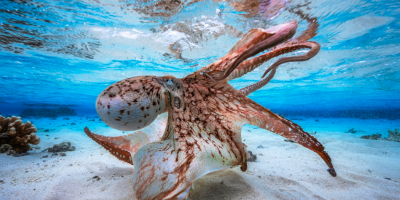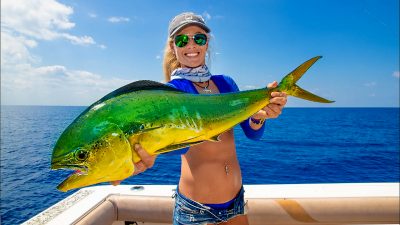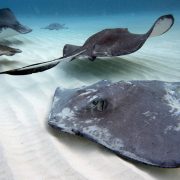Stingrays are a group of sea rays, which are cartilaginous fish related to sharks. They are classified in the suborder Myliobatoidei of the order Myliobatiformes and consist of eight families: Hexatrygonidae (sixgill stingray), Plesiobatidae (deepwater stingray), Urolophidae (stingarees), Urotrygonidae (round rays), Dasyatidae (whiptail stingrays), Potamotrygonidae (river stingrays), Gymnuridae (butterfly rays), and Myliobatidae (eagle rays).
The southern stingray (Hypanus americanus) is a whiptail stingray found in tropical and subtropical waters of the Western Atlantic Ocean from New Jersey to southern Brazil. It has a flat, diamond-shaped disc, with a mud brown, olive, and grey dorsal surface and white underbelly (ventral surface). The barb on its tail is serrated and covered in a venomous mucus, used for self-defense.
Photo Gallery
Morphology
The southern stingray is adapted for life on the sea bed. Its flattened, diamond-shaped body is more angular than other rays. The top of the body varies between olive brown and green in adults, dark grey in juveniles, whilst the underside is white.
The wing-like pectoral fins are used to propel the stingray across the ocean bottom, whilst the slender tail possesses a long, serrated and venomous spine at the base, used for defense.
These spines are not fatal to humans, but are incredibly painful if stepped on. The eyes are situated on top of the head of the southern stingray, along with small openings called spiracles.
The location of the spiracles enables the stingray to take in water whilst lying on the seabed, or when partially buried in sediment. Female stingrays can grow to a disc width of 150 cm, while the smaller male stingrays reach a maximum size of 67 cm.
Habitat & Range
Southern rays can be found in the tropical and subtropical waters of the western Atlantic Ocean, the Caribbean and the Gulf of Mexico, down the coast to southeastern Brazil. They make their home in shallow coastal waters to a depth of 180 feet and prefer lagoon or coral reef habitats where there are sandy bottoms and seagrass beds. Costambar beach divers can encounter several types of rays when diving off the coast.
On Video
Feeding & Mating
The southern stingray spends most of its time exposing prey buried in the substrate, by unsettling the sandy bottoms and creating sinks on the sea bed, by flapping their pectoral fins and shooting out water from their mouths. They mostly feed on bivalves, worms, shrimps and even small fish that they can scavenge.
This species is considered to be ovoviviparous (incubating eggs internally to give birth to live young), where the female can have 2–10 pups (born 17–34cm in width) in a litter for which the developmental period is 4.5–7.5 months. They can reproduce annually in the wild, but if in captivity, the ray can reproduce twice a year and can even grow larger when mature.
stingray Behavior
Stingrays are known for their stingers, but they are actually very docile creatures. When not feeding, southern stingrays bury themselves in the sand with only their eyes and spiracles visible. They can be found individually, in pairs, or in loose groups.
If threatened, they can raise their tails like a scorpion and stab predators with their venomous barb. However, they are more likely to swim away from predators.
The most famous stingray injury accident happened with a gigantic eight-foot-wide specimen that caused the untimely death of Steve Irwin; because he pursued the ray from behind, -the sun casting a shadow over the animal- and it perceived him as a threat, possibly a tiger shark (its main predator). The tail barb hit him straight in the heart multiple times, a one in a million chance.
More Sources:
- Caribbean Reef – Stingrays
- Wikipedia – Stingrays
- Southern Stingray
- Rays Identification Guide
- Southern Stingray Facts















